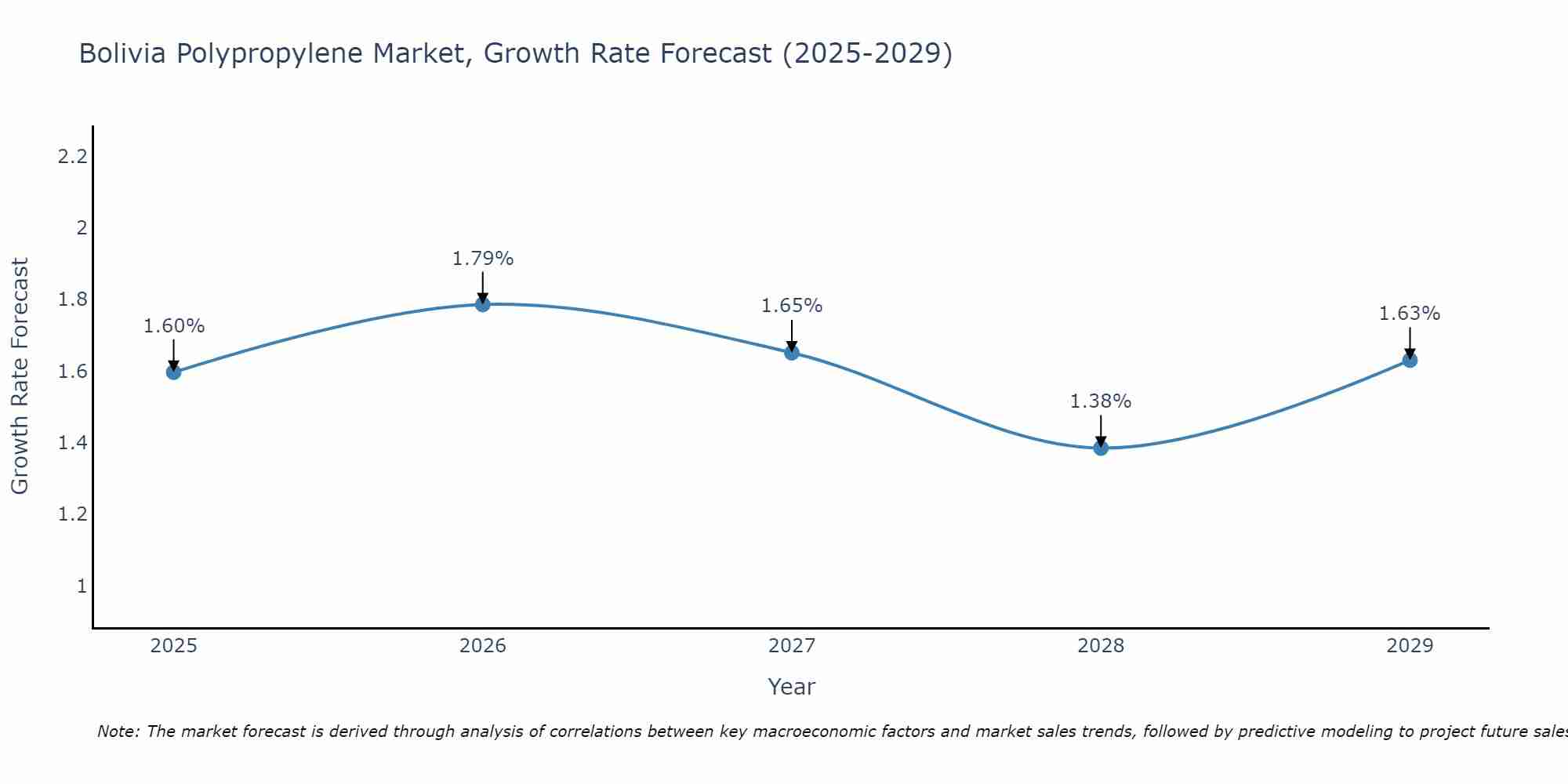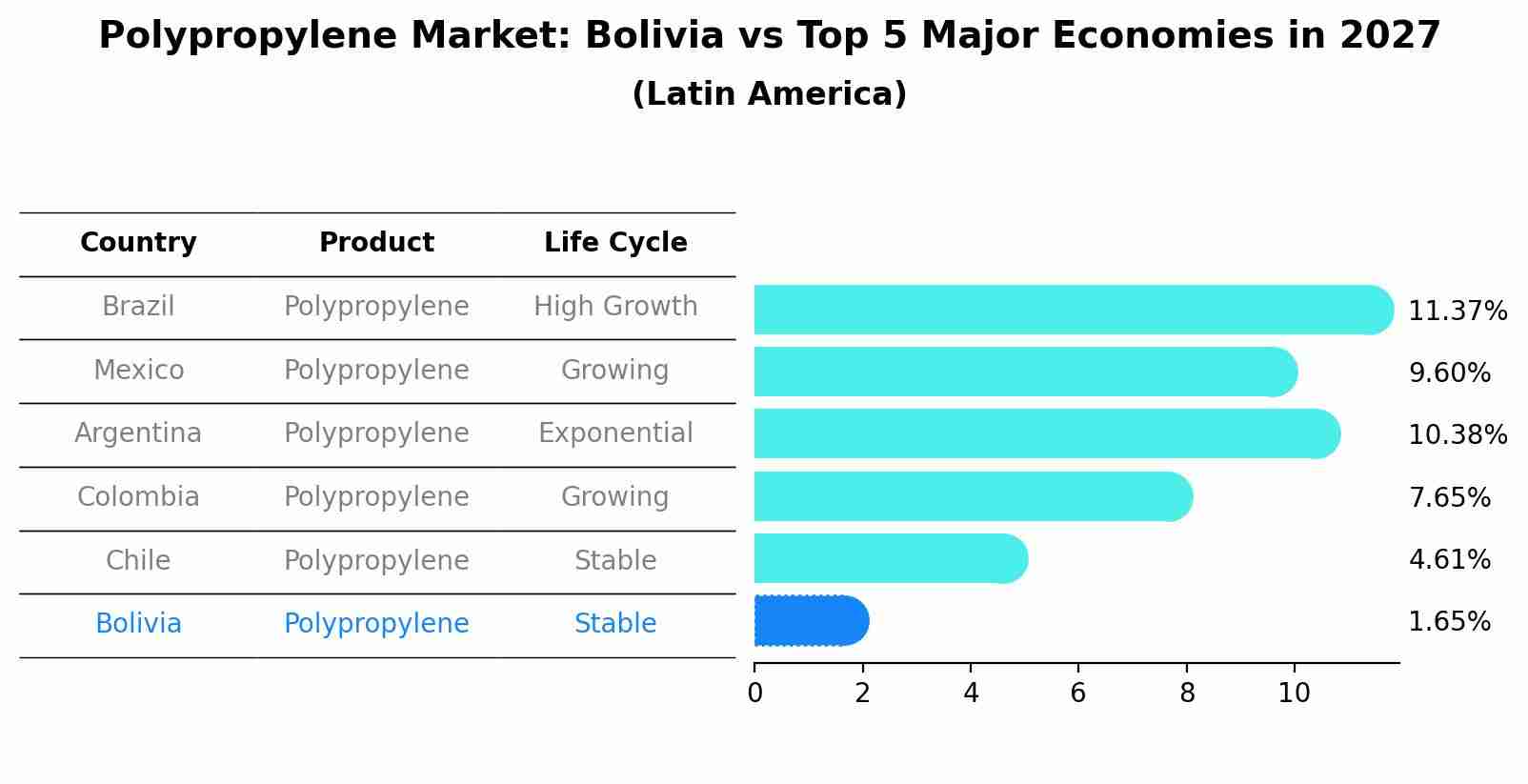Bolivia Polypropylene Market (2025-2031) | Outlook, Growth, Forecast, Share, Segmentation, Industry, Trends, Analysis, Companies, Revenue, Size & Value
| Product Code: ETC5054406 | Publication Date: Nov 2023 | Updated Date: Sep 2025 | Product Type: Market Research Report | |
| Publisher: 6Wresearch | Author: Sachin Kumar Rai | No. of Pages: 60 | No. of Figures: 30 | No. of Tables: 5 |
Bolivia Polypropylene Market Size Growth Rate
The Bolivia Polypropylene Market is projected to witness mixed growth rate patterns during 2025 to 2029. Starting at 1.60% in 2025, the market peaks at 1.79% in 2026, and settles at 1.63% by 2029.

Polypropylene Market: Bolivia vs Top 5 Major Economies in 2027 (Latin America)
In the Latin America region, the Polypropylene market in Bolivia is projected to expand at a stable growth rate of 1.65% by 2027. The largest economy is Brazil, followed by Mexico, Argentina, Colombia and Chile.

Bolivia Polypropylene Market Overview
Bolivia`s polypropylene market is experiencing growth due to the material`s wide range of applications, including packaging, automotive parts, and textiles. Polypropylene`s properties, such as resistance to chemicals and moisture, contribute to its popularity. The market is driven by increased industrial production and consumer demand for versatile and cost-effective materials. Challenges include environmental concerns and competition from alternative polymers.
Drivers of the market
The Bolivia Polypropylene market is driven by its widespread applications in various industries, including packaging, textiles, and automotive. Polypropylene is valued for its versatility, durability, and cost-effectiveness. The growing demand for packaged goods and the expansion of the automotive sector in Bolivia contribute to the increased use of polypropylene. Additionally, technological advancements in polymer production and processing enhance the material`s performance, further driving market growth.
Challenges of the market
The Bolivia polypropylene market faces challenges such as high production costs, limited local production facilities, and a dependence on imports for raw materials. This reliance can lead to supply chain issues and price fluctuations. Furthermore, there is a need for greater investment in technology and infrastructure to enhance local production capabilities and meet growing market demands.
Government Policy of the market
The polypropylenes market in Bolivia is influenced by government policies aimed at expanding the chemical and plastics industries. The Bolivian government provides tax incentives and subsidies to polypropylene manufacturers and promotes investment in infrastructure to support industry growth. Additionally, policies to improve the supply chain and logistics for polypropylene products are in place to boost market efficiency.
Key Highlights of the Report:
- Bolivia Polypropylene Market Outlook
- Market Size of Bolivia Polypropylene Market, 2024
- Forecast of Bolivia Polypropylene Market, 2031
- Historical Data and Forecast of Bolivia Polypropylene Revenues & Volume for the Period 2021-2031
- Bolivia Polypropylene Market Trend Evolution
- Bolivia Polypropylene Market Drivers and Challenges
- Bolivia Polypropylene Price Trends
- Bolivia Polypropylene Porter`s Five Forces
- Bolivia Polypropylene Industry Life Cycle
- Historical Data and Forecast of Bolivia Polypropylene Market Revenues & Volume By Type for the Period 2021-2031
- Historical Data and Forecast of Bolivia Polypropylene Market Revenues & Volume By Homopolymer for the Period 2021-2031
- Historical Data and Forecast of Bolivia Polypropylene Market Revenues & Volume By Copolymer for the Period 2021-2031
- Historical Data and Forecast of Bolivia Polypropylene Market Revenues & Volume By Application for the Period 2021-2031
- Historical Data and Forecast of Bolivia Polypropylene Market Revenues & Volume By Injection Molding for the Period 2021-2031
- Historical Data and Forecast of Bolivia Polypropylene Market Revenues & Volume By Fiber & Raffia for the Period 2021-2031
- Historical Data and Forecast of Bolivia Polypropylene Market Revenues & Volume By Film & Sheet for the Period 2021-2031
- Historical Data and Forecast of Bolivia Polypropylene Market Revenues & Volume By Blow Molding for the Period 2021-2031
- Historical Data and Forecast of Bolivia Polypropylene Market Revenues & Volume By End-use Industry for the Period 2021-2031
- Historical Data and Forecast of Bolivia Polypropylene Market Revenues & Volume By Packaging for the Period 2021-2031
- Historical Data and Forecast of Bolivia Polypropylene Market Revenues & Volume By Automotive for the Period 2021-2031
- Historical Data and Forecast of Bolivia Polypropylene Market Revenues & Volume By Building & Construction for the Period 2021-2031
- Historical Data and Forecast of Bolivia Polypropylene Market Revenues & Volume By Electrical & Electronics for the Period 2021-2031
- Historical Data and Forecast of Bolivia Polypropylene Market Revenues & Volume By Medical for the Period 2021-2031
- Bolivia Polypropylene Import Export Trade Statistics
- Market Opportunity Assessment By Type
- Market Opportunity Assessment By Application
- Market Opportunity Assessment By End-use Industry
- Bolivia Polypropylene Top Companies Market Share
- Bolivia Polypropylene Competitive Benchmarking By Technical and Operational Parameters
- Bolivia Polypropylene Company Profiles
- Bolivia Polypropylene Key Strategic Recommendations
Frequently Asked Questions About the Market Study (FAQs):
1 Executive Summary |
2 Introduction |
2.1 Key Highlights of the Report |
2.2 Report Description |
2.3 Market Scope & Segmentation |
2.4 Research Methodology |
2.5 Assumptions |
3 Bolivia Polypropylene Market Overview |
3.1 Bolivia Country Macro Economic Indicators |
3.2 Bolivia Polypropylene Market Revenues & Volume, 2021 & 2031F |
3.3 Bolivia Polypropylene Market - Industry Life Cycle |
3.4 Bolivia Polypropylene Market - Porter's Five Forces |
3.5 Bolivia Polypropylene Market Revenues & Volume Share, By Type, 2021 & 2031F |
3.6 Bolivia Polypropylene Market Revenues & Volume Share, By Application, 2021 & 2031F |
3.7 Bolivia Polypropylene Market Revenues & Volume Share, By End-use Industry, 2021 & 2031F |
4 Bolivia Polypropylene Market Dynamics |
4.1 Impact Analysis |
4.2 Market Drivers |
4.2.1 Increasing demand for lightweight and durable packaging solutions |
4.2.2 Growing usage of polypropylene in automotive and construction industries |
4.2.3 Rising adoption of polypropylene in the production of consumer goods |
4.3 Market Restraints |
4.3.1 Fluctuating prices of raw materials such as propylene |
4.3.2 Environmental concerns related to the disposal of polypropylene products |
4.3.3 Competition from alternative materials like polyethylene and polyvinyl chloride |
5 Bolivia Polypropylene Market Trends |
6 Bolivia Polypropylene Market Segmentations |
6.1 Bolivia Polypropylene Market, By Type |
6.1.1 Overview and Analysis |
6.1.2 Bolivia Polypropylene Market Revenues & Volume, By Homopolymer, 2021-2031F |
6.1.3 Bolivia Polypropylene Market Revenues & Volume, By Copolymer, 2021-2031F |
6.2 Bolivia Polypropylene Market, By Application |
6.2.1 Overview and Analysis |
6.2.2 Bolivia Polypropylene Market Revenues & Volume, By Injection Molding, 2021-2031F |
6.2.3 Bolivia Polypropylene Market Revenues & Volume, By Fiber & Raffia, 2021-2031F |
6.2.4 Bolivia Polypropylene Market Revenues & Volume, By Film & Sheet, 2021-2031F |
6.2.5 Bolivia Polypropylene Market Revenues & Volume, By Blow Molding, 2021-2031F |
6.3 Bolivia Polypropylene Market, By End-use Industry |
6.3.1 Overview and Analysis |
6.3.2 Bolivia Polypropylene Market Revenues & Volume, By Packaging, 2021-2031F |
6.3.3 Bolivia Polypropylene Market Revenues & Volume, By Automotive, 2021-2031F |
6.3.4 Bolivia Polypropylene Market Revenues & Volume, By Building & Construction, 2021-2031F |
6.3.5 Bolivia Polypropylene Market Revenues & Volume, By Electrical & Electronics, 2021-2031F |
6.3.6 Bolivia Polypropylene Market Revenues & Volume, By Medical, 2021-2031F |
7 Bolivia Polypropylene Market Import-Export Trade Statistics |
7.1 Bolivia Polypropylene Market Export to Major Countries |
7.2 Bolivia Polypropylene Market Imports from Major Countries |
8 Bolivia Polypropylene Market Key Performance Indicators |
8.1 Average selling price of polypropylene products in Bolivia |
8.2 Percentage of polypropylene used in key industries in Bolivia |
8.3 Innovation rate in polypropylene manufacturing processes |
9 Bolivia Polypropylene Market - Opportunity Assessment |
9.1 Bolivia Polypropylene Market Opportunity Assessment, By Type, 2021 & 2031F |
9.2 Bolivia Polypropylene Market Opportunity Assessment, By Application, 2021 & 2031F |
9.3 Bolivia Polypropylene Market Opportunity Assessment, By End-use Industry, 2021 & 2031F |
10 Bolivia Polypropylene Market - Competitive Landscape |
10.1 Bolivia Polypropylene Market Revenue Share, By Companies, 2024 |
10.2 Bolivia Polypropylene Market Competitive Benchmarking, By Operating and Technical Parameters |
11 Company Profiles |
12 Recommendations | 13 Disclaimer |
- Single User License$ 1,995
- Department License$ 2,400
- Site License$ 3,120
- Global License$ 3,795
Search
Related Reports
- Saudi Arabia Manlift Market (2025-2031) | Outlook, Size, Growth, Trends, Companies, Industry, Revenue, Value, Share, Forecast & Analysis
- Uganda Excavator, Crane, and Wheel Loaders Market (2025-2031) | Strategy, Consumer Insights, Analysis, Investment Trends, Opportunities, Growth, Size, Share, Industry, Revenue, Segments, Value, Segmentation, Supply, Forecast, Restraints, Outlook, Competition, Drivers, Trends, Demand, Pricing Analysis, Competitive, Strategic Insights, Companies, Challenges
- Rwanda Excavator, Crane, and Wheel Loaders Market (2025-2031) | Strategy, Consumer Insights, Analysis, Investment Trends, Opportunities, Growth, Size, Share, Industry, Revenue, Segments, Value, Segmentation, Supply, Forecast, Restraints, Outlook, Competition, Drivers, Trends, Demand, Pricing Analysis, Competitive, Strategic Insights, Companies, Challenges
- Kenya Excavator, Crane, and Wheel Loaders Market (2025-2031) | Strategy, Consumer Insights, Analysis, Investment Trends, Opportunities, Growth, Size, Share, Industry, Revenue, Segments, Value, Segmentation, Supply, Forecast, Restraints, Outlook, Competition, Drivers, Trends, Demand, Pricing Analysis, Competitive, Strategic Insights, Companies, Challenges
- Angola Excavator, Crane, and Wheel Loaders Market (2025-2031) | Strategy, Consumer Insights, Analysis, Investment Trends, Opportunities, Growth, Size, Share, Industry, Revenue, Segments, Value, Segmentation, Supply, Forecast, Restraints, Outlook, Competition, Drivers, Trends, Demand, Pricing Analysis, Competitive, Strategic Insights, Companies, Challenges
- Israel Intelligent Transport System Market (2025-2031) | Strategy, Consumer Insights, Analysis, Investment Trends, Opportunities, Growth, Size, Share, Industry, Revenue, Segments, Value, Segmentation, Supply, Forecast, Restraints, Outlook, Competition, Drivers, Trends, Demand, Pricing Analysis, Competitive, Strategic Insights, Companies, Challenges
- Uganda Precast and Aggregate Market (2025-2031) | Strategy, Consumer Insights, Analysis, Investment Trends, Opportunities, Growth, Size, Share, Industry, Revenue, Segments, Value, Segmentation, Supply, Forecast, Restraints, Outlook, Competition, Drivers, Trends, Demand, Pricing Analysis, Competitive, Strategic Insights, Companies, Challenges
- Australia IT Asset Disposal Market (2025-2031) | Strategy, Consumer Insights, Analysis, Investment Trends, Opportunities, Growth, Size, Share, Industry, Revenue, Segments, Value, Segmentation, Supply, Forecast, Restraints, Outlook, Competition, Drivers, Trends, Demand, Pricing Analysis, Competitive, Strategic Insights, Companies, Challenges
- UAE Building Thermal Insulation Market Outlook (2025-2031) | Revenue, Companies, Share, Trends, Growth, Size, Forecast, Industry, Analysis & Value
- Portugal Electronic Document Management Market (2025-2031) | Strategy, Consumer Insights, Analysis, Investment Trends, Opportunities, Growth, Size, Share, Industry, Revenue, Segments, Value, Segmentation, Supply, Forecast, Restraints, Outlook, Competition, Drivers, Trends, Demand, Pricing Analysis, Competitive, Strategic Insights, Companies, Challenges
Industry Events and Analyst Meet
Our Clients
Whitepaper
- Middle East & Africa Commercial Security Market Click here to view more.
- Middle East & Africa Fire Safety Systems & Equipment Market Click here to view more.
- GCC Drone Market Click here to view more.
- Middle East Lighting Fixture Market Click here to view more.
- GCC Physical & Perimeter Security Market Click here to view more.
6WResearch In News
- Doha a strategic location for EV manufacturing hub: IPA Qatar
- Demand for luxury TVs surging in the GCC, says Samsung
- Empowering Growth: The Thriving Journey of Bangladesh’s Cable Industry
- Demand for luxury TVs surging in the GCC, says Samsung
- Video call with a traditional healer? Once unthinkable, it’s now common in South Africa
- Intelligent Buildings To Smooth GCC’s Path To Net Zero













